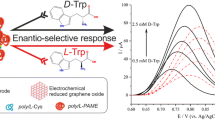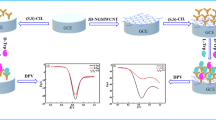Abstract
“Inherently chiral” thiophene-based electroactive oligomer films have recently been shown to exhibit outstanding chirality manifestations. One of the most exciting among them is an unprecedented enantioselection ability as electrode surfaces. In fact, in preliminary chiral voltammetry experiments, the new electrodes have been shown to both discriminate the enantiomers of chiral probes (either enantiopure or in a mixture, in terms of large differences in peak potentials) and quantify them (in terms of linear dynamic ranges in peak currents), without the need for preliminary separation steps. Such ability has now been tested on a series of chiral DOPA-related molecules, from phenolic amino acid tyrosine (together with its methyl ester) to catecholic amino acid DOPA (together with its methyl ester), to catecholamine epinephrine (adrenaline). The wide-range enantioselectivity of the new inherently chiral electrode surfaces is fully confirmed, as large peak potential differences are obtained for probe enantiomers of the whole series working in common aqueous buffers. Moreover, interesting modulating effects on enantiodiscrimination can be observed as a function of both molecular structure and pH.

Inherently chiral thiophene-based electrodes at work with pharmaceutically relevant probes






Similar content being viewed by others
References
Berthod A. Chiral recognition mechanisms. Anal Chem. 2006;78:2093–9.
Trojanowicz M, Kaniewska M. Electrochemical chiral sensors and biosensors. Electroanalysis. 2009;21:229–38.
Zhang J, Albelda MT, Liu Y, Canary JW. Chiral nanotechnology. Chirality. 2005;17:404–20.
Inose Y, Moniwa S, Aramata A, Yamagishi A, Naing K. Chiral monolayer of self-assembled Δ-[Os(bpy) 2L(Cl)]+ [bpy = 2,2′-bipyridyl, L = 1,2-bis(4-pyridyl)ethane] on a platinum electrode. Chem Commun. 1997;111–112.
Han Q, Chen Q, Wang Y, Zhou J, Fu Y. Enantioselective recognition of Dopa Enantiomers in the presence of ascorbic acid or tyrosine. Electroanalysis. 2012;24:332–7.
Nakanishi T, Matsunaga M, Nagasaka M, Asahi T, Osaka T. Enantioselectivity of redox reaction of DOPA at the gold electrode modified with a self-assembled monolayer of homocysteine. J Am Chem Soc. 2006;128:13322–3.
Zhou J, Wang L, Chen Q, Fu Y, Wang Y. Selective response of antigen-antibody reactions on chiral surfaces modified with 1,2-diphenylethylenediamine enantiomers. Surf Interface Anal. 2012;44:170–4.
Zhou Y, Yu B, Levon K. Potentiometric sensing of chiral amino acids. Chem Mater. 2003;15:2774–9.
Cichelli J, Zharov I. Chiral permselectivity in surface-modified nanoporous opal films. J Am Chem Soc. 2006;128:8130–1.
Pleus S, Schwientek M. Enantioselective electrodes: synthesis and use of polypyrroles prepared from chiral pyrrole derivatives. Synth Met. 1998;95:233–8.
Dong L, Lu B, Duan X, Xu J, Hu D, Zhang K, et al. Novel chiral PEDOTs for selective recognition of 3,4-dihydroxyphenylalanine enantiomers: synthesis and characterization. J Polym Sci A Polym Chem. 2015;53:2238–51.
Lemaire M, Delabouglise D, Garreau R, Guy A, Roncali J. Enantioselective chiral poly(thiophenes). J Chem Soc Chem Commun. 1988;658–661.
Fireman-Shoresh S, Turyan I, Mandler D, Avnir D, Marx S. Chiral electrochemical recognition by very thin molecularly imprinted sol–gel films. Langmuir. 2005;21:7842–7.
Pernites RB,Venkata SK, Tiu BDB, Yago ACC, Advincula RC. Nanostructured, molecularly imprinted, and template-patterned polythiophenes for chiral sensing and differentiation. Small. 2012;81669–1674.
Liang H, Ling T, Rick JF, Chou T. Molecularly imprinted electrochemical sensor able to enantioselectively recognize D and L-tyrosine. Anal Chim Acta. 2005;542:83–9.
Mogi I, Watanabe K. Chiral recognition of magneto-electropolymerized polyaniline film electrodes. Sci Technol Adv Mater. 2006;7:342–5.
Chen Y, Xu J, Chen C, Guo D, Fu Y. The application of L-tryptophan functionalized graphene-supported platinum nanoparticles for chiral recognition of DOPA enantiomers. New J Chem. 2015;39:6919–24.
Guo D, Ran P, Chen C, Chen Y, Xuan C, Fu Y. Study on chiral nanocomposite for recognition of DOPA enantiomers via square wave voltammetry. J Electrochem Soc. 2015;162:B354–9.
Ahmadi A, Attard G, Feliu J, Rodes A. Surface reactivity at “chiral” platinum surfaces. Langmuir. 1999;15:2420–4.
Yang H, Chi D, Sun Q, Sun W, Wang H, Lu J. Entrapment of alkaloids within silver: from enantioselective hydrogenation to chiral recognition. Chem Commun. 2014;50:8868–70.
Wattanakit C, Saint Come YB, Lapeyre V, Bopp PA, Heim M, Yadnum S, et al. Enantioselective recognition at mesoporous chiral metal surfaces. Nat Commun. 2014;5:4325/1–8.
Yutthalekha T, Warakulwit C, Limtrakul J, Kuhn A. Enantioselective recognition of DOPA by mesoporous platinum imprinted with mandelic acid. Electroanalysis. 2015;27:2209–13.
Shi H, Chen C, Tang B, Zhao G. Photoelectrochemical enantioselective recognition of amino acid enantiomers on (001) facet TiO2 surface. Electrochim Acta. 2014;146:359–64.
Torsi L, Farinola GM, Marinelli F, Tanese MC, Omar OH, Valli L, et al. A sensitivity-enhanced field-effect chiral sensor. Nat Mater. 2008;7:412–7.
Sannicolò F, Arnaboldi S, Benincori T, Bonometti V, Cirilli R, Dunsch L, et al. Potential-driven chirality manifestations and impressive enantioselectivity by inherently chiral electroactive organic films. Angew Chem Int Ed. 2014;53:2623–7.
Sannicolò F, Mussini PR, Benincori T, Cirilli R, Abbate S, Arnaboldi S, et al. Inherently chiral macrocyclic oligothiophenes: easily accessible electrosensitive cavities with outstanding enantioselection performances. Chem Eur J. 2014;20:15298–302.
Arnaboldi S, Benincori T, Cirilli R, Kutner W, Magni M, Mussini PR, et al. Inherently chiral electrodes: the tool for chiral voltammetry. Chem Sci. 2015;6:1706–11.
Sannicolò S, Mussini PR, Benincori T, Martinazzo R, Arnaboldi S, Appoloni G, et al. Inherently chiral spider-like oligothiophenes. Chem Eur J. 2016. doi:10.1002/chem.201504899.
Sannicolò F, Rizzo S, Benincori T, Kutner W, Noworyta K, Sobczak JW, et al. An effective multipurpose building block for 3D electropolymerisation: 2,2′-Bis(2,2′-bithiophene-5-yl)-3,3′bithianaphthene. Electrochim Acta. 2010;55:8352–64.
Park S, Oh H, Kang M, Cho H, Prasad JB, Won J, et al. The structure–activity relationship of the series of non-peptide small antagonists for p56lck SH2 domain. Bioorg Med Chem. 2007;15:3938–50.
Bruce Martin R, Edsall JT, Wetlaufer DB, Hollingworth B. A complete ionization scheme for tyrosine, and the ionization constant of some tyrosine derivatives. J Biol Chem. 1958;233:1429–35.
Bruce Martin R. Zwitterion formation upon deprotonation in L-3,4-dihydroxyphenylalanine and other phenolic amines. J Phys Chem. 1971;75:2657–61.
De Levie R. Aqueous acid–base equilibria and titrations. Oxford: Oxford University Press; 1999.
Bergamini MF, Santos AL, Stradiotto NR, Zanoni MVB. A disposable electrochemical sensor for the rapid determination of levodopa. J Pharm Biomed Anal. 2005;39:54–9.
Eslami M, Namazian M, Zare HR. Electrochemical behaviour of 3,4-dihydroxyphenylalanine in aqueous solution. Electrochim Acta. 2013;88:543–55.
Eslami M, Zare HR, Namazian M. Thermodynamic parameters of electrochemical oxidation of L-DOPA: experimental and theoretical studies. J Phys Chem B. 2012;116:12552–7.
Acknowledgments and funding information
The financial support of Fondazione Cariplo (Materiali avanzati 2011–0417 “Inherently Chiral Multifunctional Conducting Polymers”) is gratefully acknowledged.
The work on inherently chiral materials is also being developed in the context of the SmartMatLab Project at Dipartimento di Chimica, Università degli Studi di Milano, supported by Regione Lombardia (EU FESR and FSE), Fondazione Cariplo, Università degli Studi di Milano, and CNR ISTM.
Author information
Authors and Affiliations
Corresponding authors
Ethics declarations
Conflict of interest
The authors declare that they have no conflict of interest.
Additional information
Published in the topical collection Chemical Sensing Systems with guest editors Maria Careri, Marco Giannetto, and Renato Seeber.
An erratum to this article is available at http://dx.doi.org/10.1007/s00216-016-0103-y.
Electronic supplementary material
Below is the link to the electronic supplementary material.
ESM 1
(PDF 485 kb)
Rights and permissions
About this article
Cite this article
Arnaboldi, S., Benincori, T., Cirilli, R. et al. “Inherently chiral” thiophene-based electrodes at work: a screening of enantioselection ability toward a series of pharmaceutically relevant phenolic or catecholic amino acids, amino esters, and amine. Anal Bioanal Chem 408, 7243–7254 (2016). https://doi.org/10.1007/s00216-016-9852-x
Received:
Revised:
Accepted:
Published:
Issue Date:
DOI: https://doi.org/10.1007/s00216-016-9852-x




